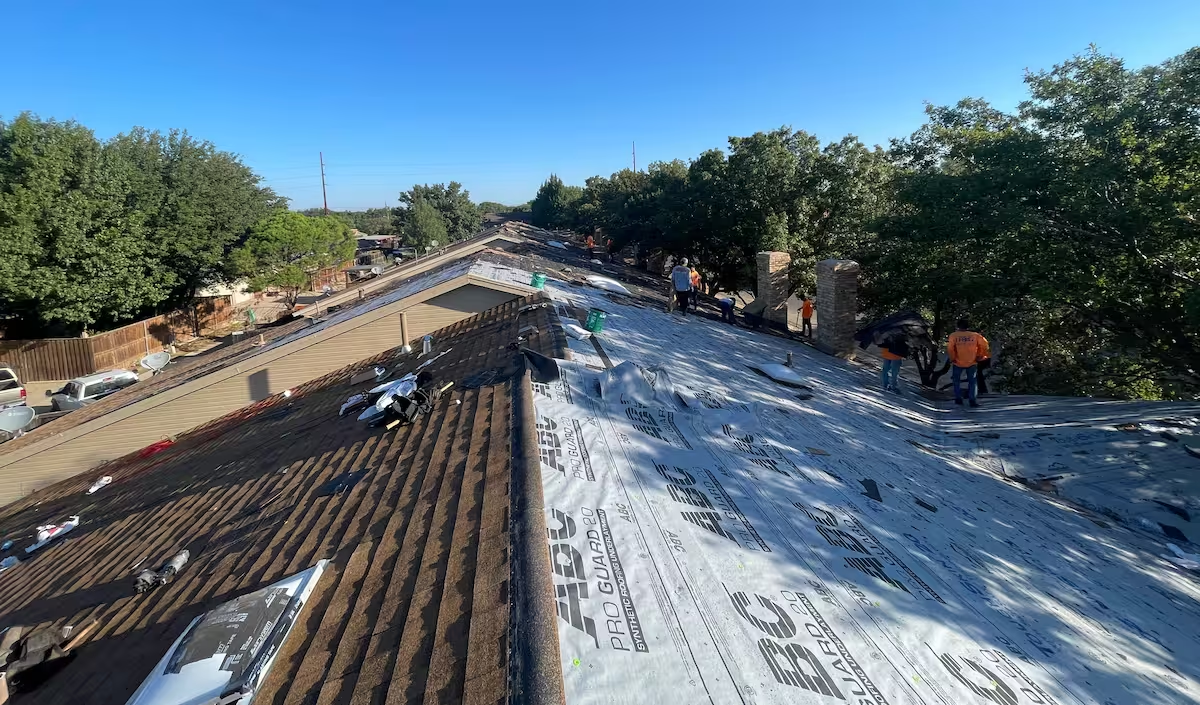Making the Critical Roof Decision
Choosing between roof repair and replacement represents one of the most significant and challenging decisions homeowners face. The wrong choice can cost thousands in unnecessary expenses or lead to repeated problems that ultimately require the more expensive solution anyway.
Understanding the key factors that determine when repair makes sense versus when replacement becomes necessary helps ensure you make the most cost-effective decision that provides optimal long-term value and protection for your home.
The 50% Rule: A Starting Point
Professional roofers often use the "50% rule" as an initial guideline for this decision. If repairs cost more than 50% of replacement cost, replacement usually makes more financial sense, especially when considering long-term value and performance.
Cost Comparison Framework
- Calculate total repair costs including all identified issues
- Obtain replacement estimates for comparison
- Factor in remaining roof lifespan after repairs
- Consider energy efficiency improvements with replacement
Beyond Simple Math
While the 50% rule provides a useful starting point, other factors like roof age, extent of damage, and future maintenance costs significantly influence the optimal decision for your specific situation.
Age and Remaining Lifespan Analysis
Roof age represents the most critical factor in the repair versus replacement decision. Newer roofs benefit from repairs while older roofs often require replacement to avoid ongoing maintenance costs and reliability issues.
Age-Based Guidelines
- 0-10 years: Repairs almost always make sense unless catastrophic damage
- 10-15 years: Evaluate extent of damage and remaining warranty coverage
- 15-20 years: Consider replacement if major repairs are needed
- 20+ years: Replacement typically provides better long-term value
Material-Specific Lifespans
Different materials have varying expected lifespans that influence replacement timing. Asphalt shingles typically last 20-25 years, while metal roofing can provide 40-70 years of service with proper maintenance.
Extent and Type of Damage Assessment
The scope and nature of roofing problems significantly influence whether repair or replacement provides the optimal solution. Localized damage favors repair while widespread issues indicate replacement as the more cost-effective approach.
Repair-Suitable Damage
- Limited areas of missing or damaged shingles
- Isolated flashing problems around penetrations
- Minor granule loss without widespread deterioration
- Small leaks with identifiable sources
Replacement-Indicating Problems
- Multiple leak locations throughout the roof
- Widespread shingle deterioration or granule loss
- Structural sagging or decking problems
- Repeated repair failures in different areas
Storm Damage Considerations
Hail, wind, and storm damage requires careful professional assessment to determine repair feasibility. Insurance coverage may influence the decision by making replacement more affordable than out-of-pocket repairs.
Financial Analysis and Long-Term Value
Comprehensive financial analysis considers not just immediate costs but long-term expenses, energy savings, and property value impacts. Replacement often provides better value when considering total ownership costs over time.
Repair Cost Factors
- Material costs for damaged areas
- Labor charges for repair work
- Potential for additional problems discovery during repairs
- Ongoing maintenance needs for aging roof sections
Replacement Investment Benefits
- Comprehensive warranty coverage for entire system
- Energy efficiency improvements reducing utility costs
- Increased property value and curb appeal
- Elimination of ongoing repair and maintenance expenses
"The cheapest option today isn't always the most economical choice over time. Smart homeowners consider long-term costs, reliability, and value when making roofing decisions."
Energy Efficiency and Modern Technology
Roof replacement provides opportunities to incorporate modern energy-efficient materials and technologies that aren't available through repairs. Energy savings can offset replacement costs while improving home comfort and environmental impact.
Efficiency Upgrade Opportunities
- Cool roof materials with superior solar reflectance
- Improved insulation and ventilation systems
- Solar panel compatibility and integration
- Advanced underlayment and moisture barriers
Technology Advantages
Modern roofing materials offer improved durability, weather resistance, and performance compared to older products. Replacement allows access to the latest technologies that can extend roof life and reduce maintenance needs.
Insurance and Warranty Considerations
Insurance coverage and existing warranties significantly influence the repair versus replacement decision by affecting out-of-pocket costs and future protection.
Insurance Impact Factors
- Coverage limits and deductible amounts
- Depreciation calculations for older roofs
- Matching requirements for partial replacements
- Premium changes based on roof age and condition
Warranty Considerations
Repairs may void existing warranties or provide limited coverage compared to full replacement warranties. New roof warranties typically offer 15-50 years of comprehensive protection depending on materials and installation quality.
Professional Assessment Importance
Qualified roofing professionals provide essential expertise for making informed repair versus replacement decisions. Professional assessment identifies all issues and provides accurate cost estimates for both options.
Comprehensive Evaluation Elements
- Detailed inspection of all roofing components
- Assessment of underlying structural conditions
- Identification of potential future problem areas
- Accurate cost estimates for both repair and replacement options
Avoiding Costly Mistakes
Professional guidance helps avoid common mistakes like choosing repairs that only delay inevitable replacement or selecting replacement when targeted repairs would suffice.
Timing and Market Considerations
Market conditions, seasonal factors, and personal circumstances influence optimal timing for repair or replacement decisions. Strategic timing can save significant costs while ensuring adequate protection.
Optimal Timing Factors
- Seasonal contractor availability and pricing
- Material cost fluctuations and supply chain issues
- Personal financial situation and cash flow
- Urgency of protection needs and weather exposure
Emergency vs. Planned Decisions
Emergency situations may require immediate repairs followed by planned replacement, while non-urgent issues allow time for thorough evaluation and strategic decision-making.
Multiple Repair Red Flags
Repeated repairs often indicate that replacement would provide better long-term value and reliability. Three or more significant repairs within five years typically signal replacement needs regardless of roof age.
Escalating Repair Patterns
- Increasing frequency of repair needs
- Growing scope of each repair project
- Multiple different types of problems appearing
- Repairs failing prematurely or creating new issues
Cost Accumulation Analysis
Track total repair costs over time to identify when cumulative expenses approach replacement costs. This analysis often reveals replacement as the more economical choice.
Decision-Making Framework
Use this systematic approach to evaluate your specific situation and make the optimal choice between repair and replacement.
Step-by-Step Evaluation
- Determine exact roof age and remaining expected lifespan
- Obtain professional assessment of all current and potential issues
- Calculate comprehensive repair costs including future maintenance
- Get detailed replacement estimates with warranty information
- Evaluate insurance coverage and potential claim benefits
- Consider energy efficiency improvements and long-term savings
- Assess personal financial situation and timing preferences
Decision Matrix Approach
Create a comparison matrix weighing immediate costs, long-term expenses, reliability, warranty coverage, and energy efficiency for both options.
Financing and Budget Planning
Understanding financing options helps make replacement affordable even when immediate cash flow favors repairs. Many contractors offer financing programs that make replacement accessible while providing better long-term value.
Financing Considerations
- Contractor financing programs with competitive rates
- Home equity loans for larger replacement projects
- Insurance claim advances and payment timing
- Tax credits and rebates for energy-efficient materials
Budget Impact Analysis
Consider monthly payment options versus lump sum expenses, and factor in energy savings that can offset financing costs over time.
Making the Final Decision
After thorough evaluation, the optimal choice becomes clear based on your specific circumstances, priorities, and long-term goals for your property.
Repair Makes Sense When:
- Roof is less than 15 years old with isolated damage
- Repair costs are significantly less than 50% of replacement cost
- Existing roof has substantial remaining warranty coverage
- Damage is limited to small, easily addressed areas
Replacement Provides Better Value When:
- Roof is approaching or exceeding expected lifespan
- Multiple problems exist or repairs have been frequent
- Energy efficiency improvements would provide significant savings
- Insurance coverage makes replacement financially attractive
Conclusion
The decision between roof repair and replacement requires careful evaluation of age, damage extent, costs, and long-term value considerations. While repairs make sense for newer roofs with isolated problems, replacement often provides better value for older roofs or those with multiple issues. Professional assessment is essential for accurate evaluation and cost estimates. Consider not just immediate expenses but long-term reliability, energy efficiency, and warranty protection when making your decision. The right choice protects your investment while providing optimal value and peace of mind for years to come. Take time to thoroughly evaluate all factors and consult with experienced professionals to ensure you make the decision that best serves your specific situation and long-term goals.
.png)



